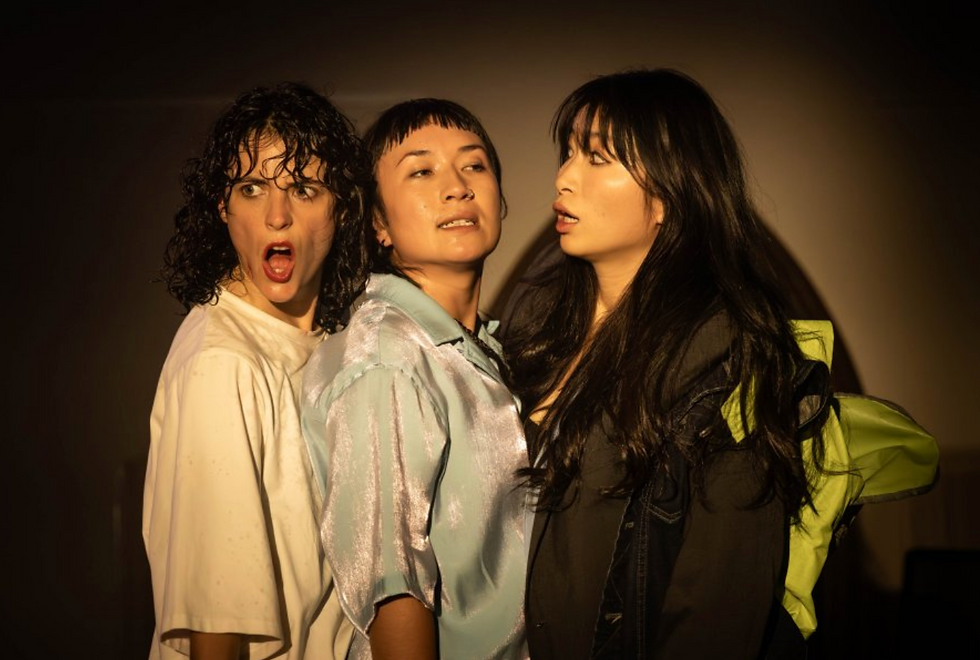Review: Little Eyolf at TW Explosives Factory
- Theatre Travels

- Dec 4, 2022
- 4 min read
Review by Thomas Gregory
Burning House productions has a reputation for taking older plays you have likely seen, read, or at least heard of before and making them something new. Little Eyolf, one of Ibsen’s lesser-known works, is rarely given a chance to be staged, so the simple existence of this production is wonderful for Melbourne.
As part of their partnership with Heartstring, Burning House was able to secure the incredible skills of Elisa Armstrong. Her take on Rita as a frustrated wife placed into an unfair situation will tug at the heart of the most cynical audience member, and the anger portrayed is both frightening and easy to empathise with.
The Alfred of this interpretation of Eyolf has far more faults than a close reading of the play would infer. The menacing selfishness of this version is portrayed brilliantly by Damien Harrison. This Alfred is concerned only with his own desires, to the point of developing extremely unhealthy relationships with every other character. That we still feel for him as a mourning father and believe in a possible redemption by the end of the play is all to the credit of Harrison.
Alexander Tomisich is used as a breath of fresh air in this play. A sincere and honest man, with no hidden agendas, his Borgheim is one you both feel sorry for and celebrate as a good person. An unfortunate aspect of Tomisich’s character, while out of the actor’s control, is how naturalistic his acting is compared to everyone else. Sometimes this means he may stand out for the wrong reasons but gets away with it by being so lovable.
Many people have praised Liliana Dalton for her eponymous role in Caligula early this year. I find this performance more compelling. The Burning House version of Asta is one without agency, trapped by a brother who has groomed her from a young age and a woman manipulated until the final scenes. Dalton captured the internal struggle of Asta, especially as someone who wants to comfort their mourning abuser. There was also a very short moment between her and “the other Eyolf” that brought a tear to the eye of at least one audience member.
Zac Steedman does a superb job for such a young Eyolf, revelling in the naive optimism of the character. While I have never been fond of Robert Johnson’s insistence on creating ghosts in his productions, I cannot complain when it means giving Steedman more time on stage.
While Ioanna Gagani’s “Rat Wife” is a small role, and the chosen direction for her is far more cliched than expected, Gagani throws herself fully into a role that truly is disturbing and compelling at the same time.
While I could rave all day about the actors, I was not as much a fan of some of the choices for them. The choice to have many scenes play out as two people standing perfectly still, giving dialogue to each other metres away, was painful to watch. Perhaps part of this pain comes from the memory of a too-close pandemic and only enjoying theatre through zoom. Perhaps it was because, for many of these scenes, one of the two was placed downstage where not a single audience would receive a good view of their face.
When actors could interact with each other, it was magical.
The theatre-goers of Melbourne may still be talking about the incredible set for Caligula, and thanks to the talented Bridie Turner, the set of Little Eyolf will be just as discussed. In a diamond layout, with the audience taking two adjacent sides, the space is broken into three distinct areas, each used to varying success. A Christmas tree with functioning lights reminds us that, for all the scenes of sexual politics, this is a story about family, and the complex relationships within it.
The centre of the stage is taken up by a child’s swimming pool. Perhaps some symbolic meaning could be found, but that was lost on me. However, its use in a single scene elevated that moment, and lighting designer, Tim Bonser, took advantage of the chance to use reflections and give other scenes an unreal quality. While I still question if it was worth taking so much space that could be used for acting, it was used successfully for the few moments it was in play.
It is worth it to mention I have seen several shows directed by Johnson, and I suspect that sometimes we are simply on different wavelengths. I have no doubt that those who loved Caligula, or my preferred, Measure of a Moment, will very much enjoy Little Eyolf. While I am intrigued by these interpretations of the characters in Little Eyolf, it is hard not to conclude that a determined vision to make some scenes spectacular led to a failure in the direction of others. These darling scenes were beautiful but stood out in the same way a Hollywood movie might add “scenes for the trailer”.
Little Eyolf is a brave new take on a brilliant Ibsen play, and sometimes it really succeeds in producing something exciting and new. While some scenes miss the mark and even may bore some theatregoers, there are more than enough moments to mark the performance as a memorable one.
Image Credit: Jack Dixon-Gunn














